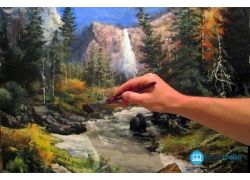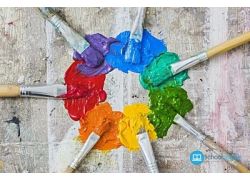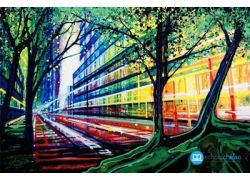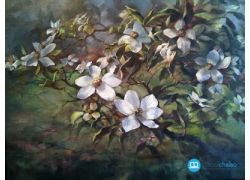Tutorial Library
Learning Point
What Do You Need To Start Your Painting
Part: 1 – Choosing a Medium
1). Consider your goal - What types of painting and art are you hoping to create? Do you need a lot of time to work on a single project, or do you want hope to fully finish pieces in a single sitting? Do you have a spacious work area that is well ventilated, or a small area that might cause fumes to build up? How much money do you hope to spend on supplies? These are all important things to consider before committing to a type of paint.

2). Try Watercolor Paint - Watercolors come in cases or small tubes of pigment. When used alone, they are thick and opaque, and do not cover much area. When used in combination with water, they will thin out and become transparent. Watercolors are used on specific paper made for use with watercolor; any old piece of paper will not necessarily work very well. These paints don’t allow thick layers of color, but give the beautiful effect of thin, translucent layers of color.
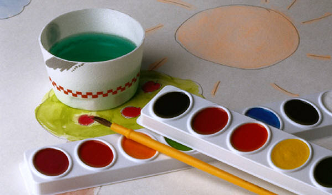
- Watercolor paint sets begin for as little as 200 rupees and can range to prices far above 1000 rupees. For a quality beginners set of paint, expect to pay between 500 rupees-800 rupees to start.
- Because watercolor can only be done on special paper that won’t wrinkle and curl when it comes into contact with water, there are limited options for things to use as a “blank canvas,” unlike acrylic and oil paints.
3). Think About Using Acrylic Color - Acrylic paints are another water-based paint option with a fast drying time and low fumes. These are a great choice for anyone interested in whipping up a completed painting in a single day. Thick layers of paint can be stacked up for a beautiful 3D effect, and because they are water soluble they can be wiped off surfaces and washed out of textiles. The downside is that because they dry so quickly, blending and wet-on-wet painting techniques can be difficult.
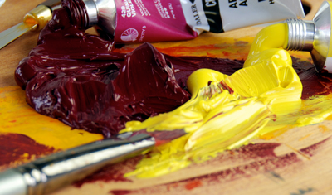
- The application style and overall appearance of acrylic paints is most similar to oil paints.
- Acrylic paints are typically less expensive than oil paints, and require many less additives. They are a bit more intuitive in terms of layering and technique than watercolor paints, though.
- Acrylic paints are much less toxic than oil paints, as they don’t give off fumes or require heavy ventilation. If you are working in a small space or have pets and children around, acrylic paint is a safer option than oil.
4). Consider Using Oil Paints - Arguably the most advanced option of the three painting mediums, oil paints are slow-drying and thick, they offer dozens of specialized techniques. These take about three months to dry completely, making them the best option for someone who needs or wants a lot of time to work on a painting to completion. On the downside, they are slightly toxic and require a great deal of ventilation when being used.
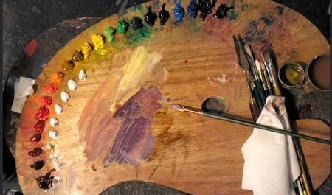
- Oil paints are the most expensive option of the three paint mediums, and require several additional supplies including mineral spirits and gels.
- Oil paints have the richest color of the three paint mediums, and will dry true to the mixed color.
5). Get Quality Paint - When you’ve decided on which type of paint you want to use, you will have to select a brand to go along with it. As a beginning painter, it is tempting to want to purchase the cheapest available brand. However, you will save yourself time and money (in the long run) by purchasing quality supplies. There are higher levels of pigment in good quality paint, meaning that a single stroke is all that is required while 2-3 may be needed to get a solid coat of paint with a cheap paint. You will end up using a cheap tube of paint much faster (and with much more frustration) than a more expensive tube of paint.
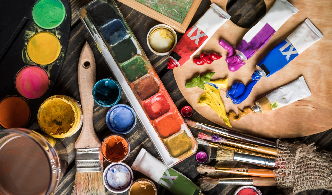
Part: 2 – Getting the Remaining Supplies
1). Choose Your Brushes - There are two primary things to pay attention to in choosing a brush: the shape of the bristles, and the material of the bristles. Bristles come in three shapes: round (with a pointed cylindrical tip), flat, and filbert (like a flat brush that comes to a point). The bristles can be made out of sable (mink), synthetic, synthetic mix, hog, or squirrel hair.
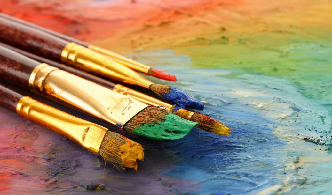
- For watercolor painting, the best brushes are sable or squirrel, with a round tip.
- The best paint brushes for acrylic painting are synthetic or synthetic mix with a flat tip.
- For oil painting, the best options to use are synthetic mix and hog with a filbert tip.
2). Get Your Canvas - Stretched canvas is the best option for acrylics and oils, as it is relatively cheap. However, thick drawing paper, canvas board, and watercolor paper are all good options as well. Oil and acrylic paints can be used on most smooth surfaces, including wood and plastic, but the surface must be primed first to allow the paint to grip. Watercolor paints can only be used on special paper or fabric.
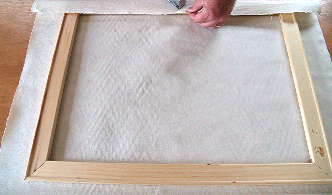
- Don’t use regular printer paper or another thin paper for painting, as the paint will be too heavy and wet and will cause it to curl and warp.
- If you plan to paint on wood or plastic, you will have to prime it first so that the paint sticks.
3). Get Your Other Supplies - In addition to those primary supplies, you will need a pallet, jars full of water (two is good), and a rag, an old shirt or apron to wear. Other specialty supplies are required for oil paints, but are not needed for watercolor or acrylics. It is helpful to get gesso as well; it is a white primer that preps any surface (canvas and paper included) to create the best painting surface.
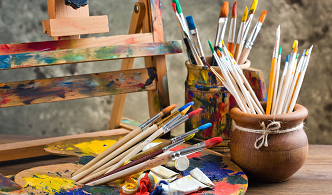
- Not necessary for most painting but often desired, an easel can be used to prop up your painting. Otherwise, any flat, stable surface will work for painting on.
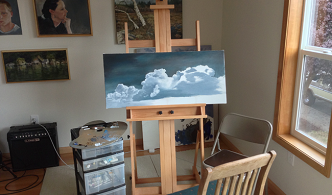
Very Useful (0)
Useful (0)
Not Useful (0)
Please login to your account by completing this form
Reset Your password
Please enter the email address you signed up with and we'll send you a password reset link.
A reset password link has been generated and will be sent to you via email.
You can then follow that link and select a new password.
Completing that action will allow you to reset your password and then you can insert a new one.
Please enter the email address you signed up with and we'll send you a password reset link.
A reset password link has been generated and will be sent to you via email.
You can then follow that link and select a new password.
Completing that action will allow you to reset your password and then you can insert a new one.
